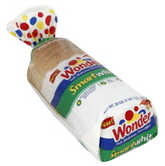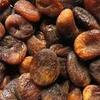
I saw this article in King Arthur's newsletter and thought it was interesting, because most folks don't know the difference between Hard White and Hard Red wheat. American consumers are again being misled on what they are really buying, advertisers are now promoting "Whole Grain White Bread". Now you would think this is a good thing it's bread made with Hard White wheat using the whole berry, logically that would make sense but beware read the label.
The Wonder Bread's, "Smartwhite" website proudly describes this as white bread “with all the fiber of 100% whole wheat." What you will not see on the product label, however, is any trace of whole wheat flour. In fact on the label the first couple of ingredients are; "water, wheat flour, cottonseed fiber, wheat gluten, corn syrup high fructose or sugar, yeast", and 32 other ingredients. What they are adding to achieve the fiber in the bread is cottonseed fiber, which is softer than wheat bran and does not deliver the same nutrients. To compensate for the lack of nutrition, vitamins and minerals have to be added back in. There are 40 ingredients total on the label for a loaf of bread, and people wonder why we have a problem digesting wheat, it's not the wheat it's what we do to it and the additives we add.
There are other products of similar supposedly "whole grain white breads", made by Wonder and Franz, that actually contain some whole wheat flour. The problem is when you look closely, you will find that the first ingredient is still “enriched wheat flour,” which is white processed flour (bran and germ removed) plus added vitamins and minerals. You will find whole wheat flour third on the list after water. These first three ingredients are followed by some 40-plus other ingredients that are added in order to simulate the texture and taste of white bread.
If you're family is just not thrilled with whole grain bread there are options that are kid approved. In order to make bread you need a high gluten flour and there are two of them Hard Red and Hard White. Now hard white has the same nutritional value, same gluten structure the only difference is it's lighter in color and has a milder taste. It' not only the ingredients in the bread that give it the texture it's also the method of making the bread.
I make a bread out of 100% whole grain hard white flour that is light and fluffy, has a perfect soft texture that your child or picky eater in your family will love, I call it Wonder Grain. If you stop by my booth at the Farmer's Market you can get a sample to taste for yourself. White whole wheat bread is not widely available commercially, but you can make your own by starting with white whole grain flour it's easy to make and I do offer bread making classes.
The Wonder Bread's, "Smartwhite" website proudly describes this as white bread “with all the fiber of 100% whole wheat." What you will not see on the product label, however, is any trace of whole wheat flour. In fact on the label the first couple of ingredients are; "water, wheat flour, cottonseed fiber, wheat gluten, corn syrup high fructose or sugar, yeast", and 32 other ingredients. What they are adding to achieve the fiber in the bread is cottonseed fiber, which is softer than wheat bran and does not deliver the same nutrients. To compensate for the lack of nutrition, vitamins and minerals have to be added back in. There are 40 ingredients total on the label for a loaf of bread, and people wonder why we have a problem digesting wheat, it's not the wheat it's what we do to it and the additives we add.
There are other products of similar supposedly "whole grain white breads", made by Wonder and Franz, that actually contain some whole wheat flour. The problem is when you look closely, you will find that the first ingredient is still “enriched wheat flour,” which is white processed flour (bran and germ removed) plus added vitamins and minerals. You will find whole wheat flour third on the list after water. These first three ingredients are followed by some 40-plus other ingredients that are added in order to simulate the texture and taste of white bread.
If you're family is just not thrilled with whole grain bread there are options that are kid approved. In order to make bread you need a high gluten flour and there are two of them Hard Red and Hard White. Now hard white has the same nutritional value, same gluten structure the only difference is it's lighter in color and has a milder taste. It' not only the ingredients in the bread that give it the texture it's also the method of making the bread.
I make a bread out of 100% whole grain hard white flour that is light and fluffy, has a perfect soft texture that your child or picky eater in your family will love, I call it Wonder Grain. If you stop by my booth at the Farmer's Market you can get a sample to taste for yourself. White whole wheat bread is not widely available commercially, but you can make your own by starting with white whole grain flour it's easy to make and I do offer bread making classes.


 RSS Feed
RSS Feed
